Etymology and meaning
''Saṃskāra'' (Sanskrit: संस्कार) has various context-driven meanings, that broadly refer to "the putting together, accomplishing well, making perfect, a form of solemn recognition and getting ready, engaging in works and acknowledging the purification of body by cleansing or mind by education or an object by a process (such as polishing a gem or refining a metal)".saMskAraMonier-Williams' Sanskrit-English Dictionary, Cologne Digital Sanskrit Lexicon, Germany The term appears in the Śrutis, and in the Smritis of diverse schools of Hinduism as well as the texts of Jainism, Buddhism and Sikhism. The etymological roots of the word ''samskara'' when it refers to rites of passage, is also "preparation, purifying, perfecting" from one's past state to one's future state. The word ''samskara'' is rare in the oldest layer of Vedic literature, but its roots ''sam'' and ''kr'' occur often enough. The word appears in Rig Veda hymns 6.28.4 and 8.33.9, as well as other Vedic texts, where the context suggests it simply means "purify, prepare". It appears in Jaimini Purvamimamsa-sutra (500-200 BCE) many times, where it again means "prepare, perfect, polish" something, either through action, speech or mind.Rajbali Pandey (2013), Hindu Saṁskāras: Socio-religious Study of the Hindu Sacraments, 2nd Edition, Motilal Banarsidass, , pages 15-16 In sections 3.8.3, 9.3.25 and 10.2.49 of the Jaimini Purvamimamsa-sutra, the word ''samskara'' is used to describe actions of "washing the teeth, shaving the head, cutting nails, sprinkling water" as part of a ceremony.PV Kane
Samskara, Chapter VI
History of Dharmasastras, Vol II, Part I, Bhandarkar Oriental Research Institute, pages 190-191 Samskara is defined by ancient Indian scholar Shabara as, "that which prepares a certain thing or person fit for a certain purpose". Another ancient text Viramitrodaya defines ''samskara'', notes Kane, as "a peculiar excellence due to performance of certain actions which resides in the soul or the body of the actor". ''samskara'' in Hindu traditions, states Kane, have been ceremonies, with the expression of outward symbols or signs of inner change, marking life events of significance. They served a spiritual, cultural and psychological purpose, welcoming an individual into a stage of life, conferring privileges to the individual(s), expecting duties from the individual, and impressing on the individual as well individual's social circle of his or her new role. ''Sanskāra'', in modern usage, is sometimes used to mean "cultural, social or religious heritage".
Samskara as a psychological concept
In the context of karma theory, Samskara are dispositions, character or behavioral traits either as default from birth (previous lives in some schools of Hinduism), or Samskara are behavioral traits perfected over time through Yoga, through conscious shaping of inner self, one's desire, sense of moral responsibility and through practice.Ian Whicher (1999), The Integrity of the Yoga Darsana: A Reconsideration of Classical Yoga, SUNY Press, , pages 100-102 In some schools of Hinduism, the psychological concept of samskara is also known asSamskara as sacraments
''Samskaras'' in Hinduism are sacraments that begin with one's birth, celebrate certain early steps in a baby's growth and his or her welcome into the world in the presence of friends and family, then various stages of life such as first learning day, graduation from school, wedding and honeymoon, pregnancy, raising a family, as well as those related to final rites associated with cremation.Jörg Gengnagel and Ute Hüsken (2005), Words and Deeds: Hindu and Buddhist Rituals in South Asia, Otto Harrassowitz Verlag, , see Preface Chapter These rites of passage are not uniform, and vary within the diverse traditions of Hinduism. Some may involve formal ceremonies, yajna (fire) ceremonies with the chanting of Vedic hymns. Others are simple, private affairs involving a couple, with or without friends, other families or a religious person such as a priest or a ''pandit''. Samskaras are not considered as an end in themselves, but are means of social recognition as well as the passage of a person from one significant stage of life to another. Various elements of ''samskaras'' and rituals of passage are mentioned in Vedas of Hinduism, one of the oldest known scriptures in the world. The most extensive, but divergent discussions of these rites of passage are found in the numerous Dharmasutras and Grhyasutras from the 1st millennium BCE.Joyce Flueckiger, Everyday Hinduism, John Wiley & Sons, , pages 169-191 Many of these rites of passage include formal ceremonies, with ritual readings of hymns, chants and ethical promises, aiming to orient the individual(s) to that which is considered part ofThe purpose
Gautama Dharmasutra enumerates a large list of "forty outer karma samskaras" and "eight inner karma samskara (good qualities)", all of whom have the purpose of empowering a human being to discover, recognize and reach union with the Brahma-Atman (his or her Soul, Self, Highest Being).Rajbali Pandey (1969, reprint 2003).The Hindu Sacraments (Saṁskāra)
' in S. Radhakrishnan (ed.) ''The Cultural Heritage of India'', 2nd Edition, Motilal Banarsidass, , pages 31-33 The ultimate purpose is to inculcate virtues, and samskaras are viewed in the Hindu tradition as means – not as ends – towards ripening and perfecting the human journey of life. The eight good qualities listed by Gautama Dharmasutra are emphasized as more important than the forty samskara rituals, in verses 8.21-8.25, as follows,
The 40 Samskaras
The '' Gautama Dharmasutra'' list the following forty rituals as outer samskaras: *Garbhadhana ( conception), Pumsavana (rite celebrating the fetus), Simantonnayana (parting of pregnant woman's hair in 8th month), Jatakarman (rite celebrating the birth), Namakarana (naming the child), Annaprashana (baby's first feeding of solid food), Choulam (baby's first haircut, tonsure), and Upanayana (entry into school rite); *the four vows associated with Vedic study; *graduation ritual at the conclusion of school; * marriage sva-dharma rite; *five sacrifices to gods, ancestors, humans, spirits, and all knowledge; *seven remembrances and donations (sacrifices) using cooked food, in the form of ancestral offerings *seven remembrances and donations (sacrifices) in the presence of fire ( yajna), to mark harvests, seasons and deities *seven kinds of Soma sacrifices: agnistoma, atyagnistoma, ukthya, sodasin, vajapeya, atiratra and aptoryama. To obtain union with Brahman, one must also possess the eight virtues (compassion, patience, non-envy, purity of thought speech and body, inner calm and peace, positive attitude, generosity, and lack of possessiveness).The 16 samskaras
There are diverse number of samskaras in Hinduism, varying by texts between 12 and 18 in the Grhyasutras (Kalpa sastras). Of these, 16 are referred to as "Shodasha Samskaras" ().Rajbali Pandey (1969, reprint 2003).The Hindu Sacraments (Saṁskāra)
' in S. Radhakrishnan (ed.) ''The Cultural Heritage of India'', 2nd Edition, Motilal Banarsidass, , page 23
Intent to have a child ritual, Garbhadhana
Nurturing the fetus rite, Pumsavana
Pumsavana (Parting hair and baby shower, Simantonnayana
Simantonnayana (Samskara, Chapter VI
History of Dharmasastras, Vol II, Part I, Bhandarkar Oriental Research Institute, pages 222-224Rajbali Pandey (1969), Hindu Saṁskāras: Socio-religious Study of the Hindu Sacraments, , pages 64-65 The significance of the ritual is to wish a healthy development of the baby and safe delivery to the mother.Mary McGee (2007), Samskara, in ''The Hindu World'' (Editors: Mittal and Thursby), Routledge, , page 341 ''Simantonnayana'' ritual is described in many Gryhasutra texts, but Kane states that there is great divergence in details, which may be because the rite of passage emerged in more a recent era, before it receded into the background. The texts do not agree on whether this rite of passage was to be celebrated before or after ''pumsavana'', early or late stage of pregnancy, or the nature of ritual celebrations. The texts also disagree whether ''Simantonnayana'' was a rite of passage of the baby or of the pregnant woman, the former implying it must be repeated for every baby while the latter implying it was to be observed once for the woman with her first pregnancy. The common element was the husband and wife getting together, with friends and family, then he parts her hair upwards at least three times. In modern times, the "parting hair" rite of passage is rarely observed, and when observed it is called ''Atha-gulem'' and done in the 8th month, with flowers and fruits, to cheer the woman in the late stages of her pregnancy. The ritual has more commonly evolved into a ritual that shares characteristics of a baby shower, where the friends and relatives of the woman meet, acknowledge and satisfy the food cravings of the expectant woman, and give gifts to the mother and the baby in the seventh or eighth month of pregnancy. Yåjñavalkya Smriti verse 3.79 asserts that the desires of the pregnant woman should be satisfied for healthy development of the baby, to prevent miscarriage and her health. After the ''Simantonnayana'' ritual or in the last months of the pregnancy, the woman is expected to not overexert herself, her husband is expected to be by her and not to travel to distant lands. This rite of passage is regionally called by various names, such as ''Seemant'', ''Godh bharai'', ''Seemantham'' or ''Valaikaapu''.
Childbirth ceremony, Jatakarman
Jātakarman literally means "rite of a new-born infant".jAtakarmanApte Sanskrit English Dictionary, University of Chicago It is a rite of passage that celebrates the birth of the baby. It is the first post-natal rite of passage of the new born baby. It signifies the baby's birth, as well as the bonding of the father with the baby.Kathy Jackson (2005), Rituals and Patterns in Children's Lives, University of Wisconsin Press, , page 46 In Hindu traditions, a human being is born at least twice – one at physical birth through mother's womb, and second at intellectual birth through teacher's care, the first is marked through ''Jatakarman'' samskara ritual, the second is marked through ''Vidyarambha'' or ''Upanayana'' samskara ritual. During a traditional ''Jātakarman'' ritual, the father welcomes the baby by touching the baby's lips with honey and ghee (clarified butter), as Vedic hymns are recited. The first significance of the hymns is ''medhajanana'' (Sanskrit: मेधाजनन), or to initiate the baby's mind and intellect in the womb of the world, after the baby's body formation has completed in the womb of the mother. The second part of the hymns wish the baby a long life. The Brihadaranyaka Upanishad, in the last chapter detailing lessons for Grihastha stage of life for a student, describes this rite of passage, in verses 6.4.24 to 6.4.27, as follows,
 The Upanishad includes prayer to deity Saraswati during this rite of passage, the goddess of knowledge and wisdom in Hindu tradition. It also includes the threefold repetition of "Speech Speech" with the assertion to the baby, "You are the Vedas! so, live a hundred autumns", into the baby's ear by the father. At the end of the ritual pronouncements by the father, he gives the baby to the mother's breast for feeding.
While the earliest Dharmasutras list Jatakarma and Namakarama as two different samskara, they evolve into one in many Gryhasutra texts. By Pantanjali's time, these two rites of passage had merged into one, and completed within the first two weeks of the baby's birth, usually about the tenth day.
The Upanishad includes prayer to deity Saraswati during this rite of passage, the goddess of knowledge and wisdom in Hindu tradition. It also includes the threefold repetition of "Speech Speech" with the assertion to the baby, "You are the Vedas! so, live a hundred autumns", into the baby's ear by the father. At the end of the ritual pronouncements by the father, he gives the baby to the mother's breast for feeding.
While the earliest Dharmasutras list Jatakarma and Namakarama as two different samskara, they evolve into one in many Gryhasutra texts. By Pantanjali's time, these two rites of passage had merged into one, and completed within the first two weeks of the baby's birth, usually about the tenth day.
Naming the baby ritual, Namakarana
Namakarana (Samskara, Chapter VI
History of Dharmasastras, Vol II, Part I, Bhandarkar Oriental Research Institute, pages 238-254 Unpleasant, inauspicious, or words that easily transform into bad or evil words must be avoided, state the Gryhasutras, while the preferred names are those affiliated with a deity, virtues, good qualities, lucky stars, constellation, derivatives of the name of the father, or mother, or the place of birth, or beautiful elements of nature (trees, flowers, birds).
Baby's first outing, Nishkramana
Nishkramana ( The significance of ''Niskramana'' and showing the baby heavenly bodies is derived from their significance of Sun, Moon and nature in the Vedic literature. At the time the baby is present before the sunrise or moon, it is the father who holds the baby and recites a hymn that means, "the brilliant sun has risen in the east, he is like the ''hamsa'' (swan) of the pure worlds, let us salute him, because he dispels darkness". When the baby is in presence of the moon, the father says, "O Moon, thou whose hair is well parted, let this child come to no harm, nor torn from the mother".PV Kane
The significance of ''Niskramana'' and showing the baby heavenly bodies is derived from their significance of Sun, Moon and nature in the Vedic literature. At the time the baby is present before the sunrise or moon, it is the father who holds the baby and recites a hymn that means, "the brilliant sun has risen in the east, he is like the ''hamsa'' (swan) of the pure worlds, let us salute him, because he dispels darkness". When the baby is in presence of the moon, the father says, "O Moon, thou whose hair is well parted, let this child come to no harm, nor torn from the mother".PV KaneSamskara, Chapter VI
History of Dharmasastras, Vol II, Part I, Bhandarkar Oriental Research Institute, pages 255-256
Baby's first solid food, Annaprashana
Annaprashana (Samskara, Chapter VI
History of Dharmasastras, Vol II, Part I, Bhandarkar Oriental Research Institute, pages 256-258
Baby's first haircut, Chudakarana
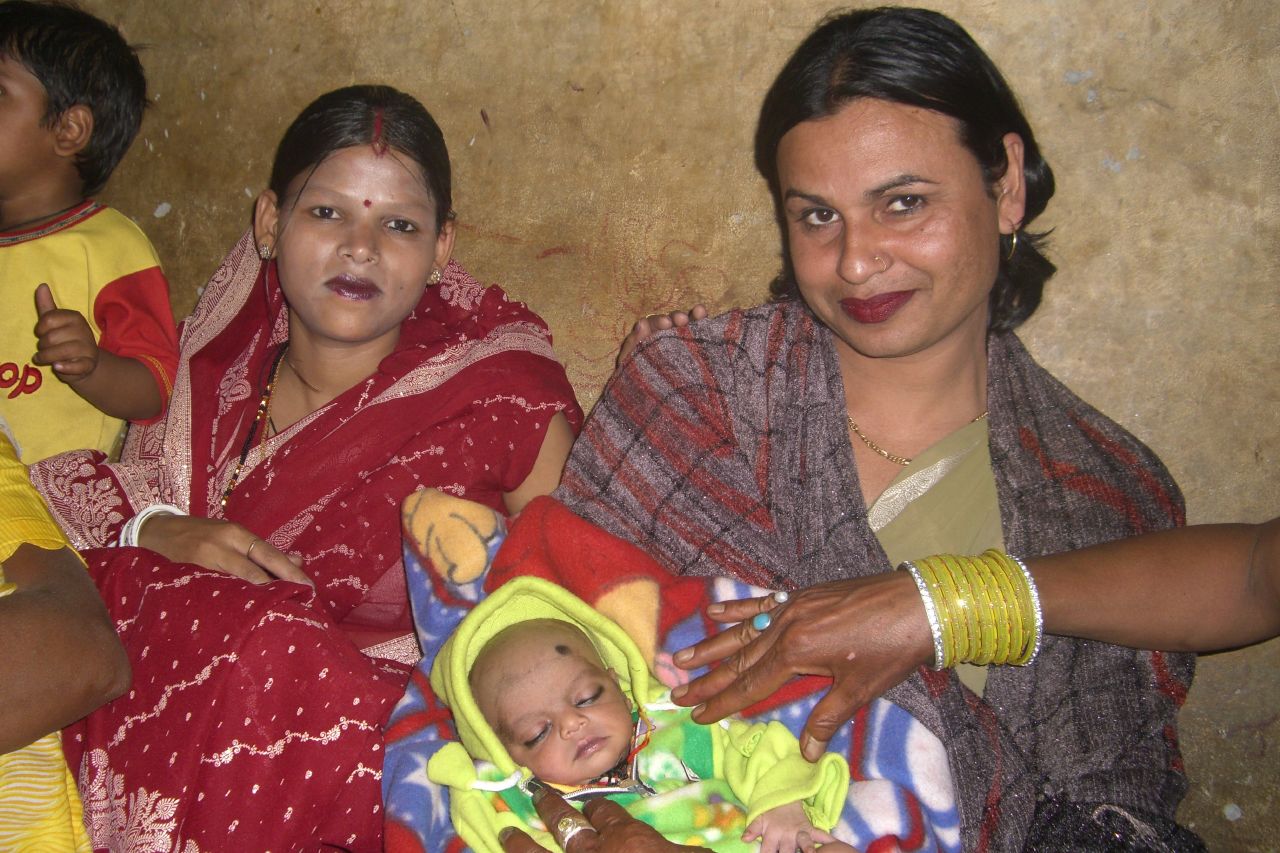
Samskara, Chapter VI
History of Dharmasastras, Vol II, Part I, Bhandarkar Oriental Research Institute, pages 260-265
Baby's earlobe piercing rite, Karnavedha
 Karnavedha (
Karnavedha (Samskara, Chapter VI
History of Dharmasastras, Vol II, Part I, Bhandarkar Oriental Research Institute, pages 254-255 The purpose of this optional ritual is primarily an ornamentation of the body, and it is part of the baby's socialization process and culture emersion. The piercing is usually done with a clean gold thread, or silver needle. For a baby boy, the right earlobe is pierced first. For a baby girl, the left earlobe is. In case of girls, the left nostril may also be pierced during this ritual. The piercing of the earlobes symbolically reminds the child, as he or she grows up, of beauty and social presence, of the importance of hearing and speech in the wisdom of the Vedas.
Child's commencement to knowledge, Vidyarambha
Vidyarambha (Samskara, Chapter VI
History of Dharmasastras, Vol II, Part I, Bhandarkar Oriental Research Institute, pages 266-267 This includes steps where the child, helped by the parents and other family members, does one or more of the following: writes letters of the mother-tongue, draws mathematical numbers or shapes, and plays a musical instrument. The oldest texts that describe rites of passage, such as the Dharmasutras, make no mention of ''Vidyarambha'' and go direct to ''Upanayana'' ritual at the eighth year. The later texts, such as the ''Samsakara Prakasha'', from the first centuries of 1st millennium CE, mention ''Vidyarambha'' as a rite of passage in the fifth year of a child's life, suggesting that the process of learning started shifting to an earlier age of a child with time. The ceremony is observed on the same day for all children in their fifth year, on the day of Vijayadasami which is on the tenth of the Hindu month Ashvin (September–October). It includes a prayer to goddess Saraswati and deity Ganesh, a teacher is invited or the parents themselves work with the child to write ''Lipi'' (letters of the alphabet), draw ''Samkhya'' (numbers) or pictures, and sometimes play with an instrument.Rajbali Pandey (2013), Hindu Saṁskāras: Socio-religious Study of the Hindu Sacraments, 2nd Edition, Motilal Banarsidass, , pages 106-108 In modern times, parents mark this rite of passage in the third year of the child.
Child's entrance into school, Upanayana
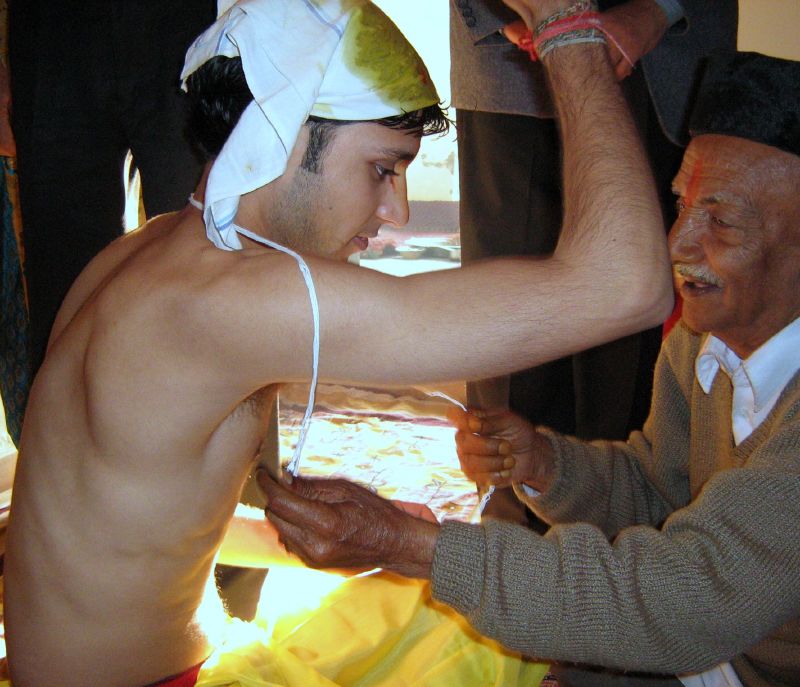 Upanayana (
Upanayana (Monier Williams Sanskrit English Dictionary, Cologne Sanskrit Digital Lexicon, Germany It is an important and widely discussed samskara in ancient Sanskrit text. The rite of passage symbolizes the leading or drawing towards the self of a child, in a school, by a teacher. It is a ceremony in which a Guru (teacher) accepts and draws a child towards knowledge and initiates the second birth that is of the young mind and spirit. Upanayana was an elaborate ceremony, that included rituals involving the family, the child and the teacher. During this ceremony, a boy receives a sacred thread called ''Yajñopaveetam'', that he wears. ''Yajñopavita'' ceremony announced that the child had entered into formal education. In the modern era, the Upanayana rite of passage is open to anyone at any age. Rajbali Pandey compares the Upanayana rite of passage to Baptism in Christianity where the person is born again unto spiritual knowledge, in addition to it being the ancient Indian rite of passage for the start of formal education of writing, numbers, reading, Vedangas, arts and other skills.Rajbali Pandey (2013), Hindu Saṁskāras: Socio-religious Study of the Hindu Sacraments, 2nd Edition, Motilal Banarsidass, , pages 111-117 The ''Upanayana'' rite of passage was also important to the teacher, as the student would therefrom begin to live in the ''Gurukul'' (school).PV Kane
Samskara, Chapter VII
History of Dharmasastras, Vol II, Part I, Bhandarkar Oriental Research Institute, pages 268-287 Many medieval era texts discuss Upanayana in the context of three ''Varnas'' (caste, class) – Brahmins, Kshtreyas and Vaishyas. Several texts such as ''Sushruta Sutrasthana'', however, also include Sudras entering schools and the formal education process, stating that the Upanayana samskara was open to everyone.PV Kane
Samskara, Chapter VII
History of Dharmasastras, Vol II, Part I, Bhandarkar Oriental Research Institute, pages 288-300 The upanayana ceremony extended to women, in ancient Sanskrit texts, and the girls who underwent this rite of passage then pursued studies were called ''Brahmavadini''. Those who did not performed upanayana ceremony at the time of their wedding. Instead of sacred thread, girls would wear their robe (now called sari or saree) in the manner of the sacred thread, that is over her left shoulder during this rite of passage.PV Kane
History of Dharmasastra
Volume 2.1, 1st Edition, pages 293-295 The education of a student was not limited to ritual and philosophical speculations found in the Vedas and the Upanishads. They extended to many arts and crafts, which had their own but similar rites of passages.Stella Kramrisch (1958)
Traditions of the Indian Craftsman
The Journal of American Folklore, Vol. 71, No. 281, pages 224-230 Aitareya Brahmana, Agamas and
Vedarambha
Praishartha (or Vedarambha) is the rite of passage that marked the start of learning the Vedas and Upanishads in ''Gurukulam'' or ''Pathashala'' (school). It was a fire ritual (''yajna''), where the teacher and the student sat together, with the teacher reciting initiation hymns and the student following. This ritual is missing in older texts, and Pandey suggests that the later tradition recognized the difference between getting accepted in a school, and the actual start of Veda studies when the student is ready to learn those texts. In ancient India, the student's preparation involved helping with school chores, living a simple life, going to villages and towns to seek donations of food (''Bhiksha''), collect and bring water, collect fuel sticks for cooking, general maintenance of the school and share the food he and others collect with his teacher and the student community. These were on-going rituals of living at living, and not considered as a distinct rite of passage. Prior to the initiation of the Veda study, the student learnt the vocabulary, grammar and other basic studies. The emphasis of the stage where the student started Veda study was both the memorization and know the meaning of each hymn, verse or mantra. Vedarambha marked the actual start of the Veda study. Some texts describes two rituals each academic period (school year), one marking the start of Vedic studies each year, called Upakarma or ''Upakarana''. The other ceremony was held at the end of each academic period, called ''Utasarjanam'' or ''Utsarga'' or ''Samapana'', and marked the suspension of the Veda studies for a certain period of the year.PV KaneUpakarana, Chapter XXIII
History of Dharmasastras, Vol II, Part II, Bhandarkar Oriental Research Institute, pages 807-811 The start of school ceremony, the Upakarma was observed in the month of Sravana (August) every year. It was held in the morning, and attended by the students, the teacher, people in the Grihastha stage (householders, parents) and Vanaprastha stage of life (retired, grandparents). The ''Utsarga'', closing the study year, was held in the month of Magha (about February).
Keshanta and Ritusuddhi
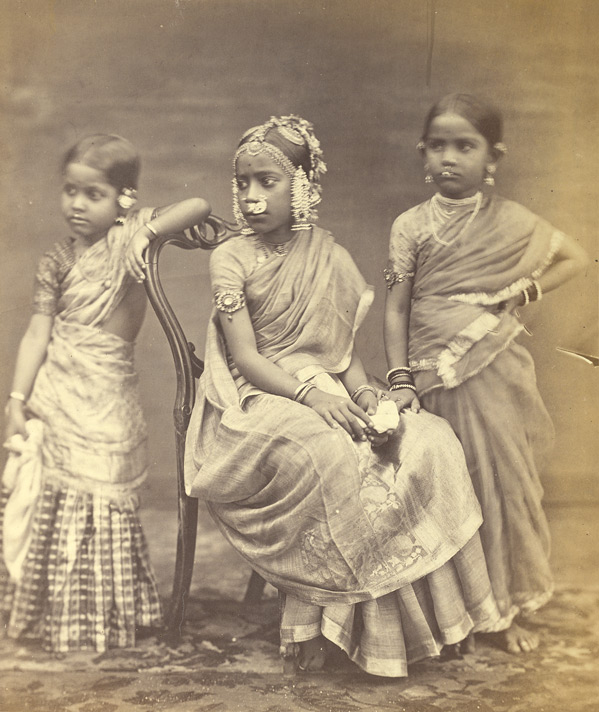
Graduation ceremony, Samavartana
Samavartana (The wedding rituals, Vivaha
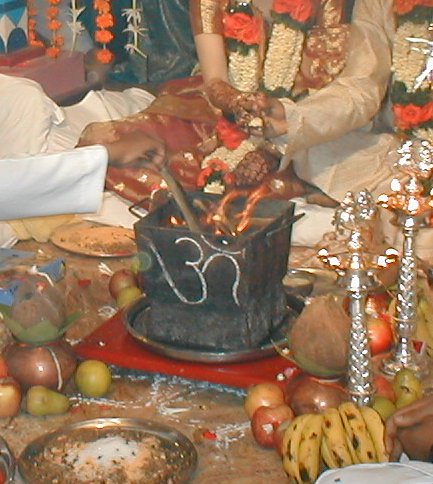 Vivaha (
Vivaha (Nawal Prinja (24 August 2009)Hindu Saṁskāras: Socio-religious Study of the Hindu Sacraments, Rajbali Pandey (1969), see Chapter VIII, , pages 153-233 While there are many rituals in Hinduism, ''vivaha'' (wedding) is the most extensive personal ritual an adult Hindu undertakes in his or her life. The wedding rites and ceremonies begin with the engagement of a couple, and extend to rites of passage after the completion of wedding. They are typically very colorful, and celebrations may extend for several days.
Amy Yee, The Financial Times, 17 May 2008 The detailed rituals and process in a Hindu wedding vary. Nevertheless, there are a few key rituals common in Hindu weddings - ''Kanyadaan'', ''Panigrahana'', and ''Saptapadi'', which are respectively, giving away of daughter by the father, voluntarily holding hand near the fire to signify union, and taking seven steps with each step includes a vow/promise to each other before fire. The Vivaha samskara is essentially a Vedic yajna ritual, with recitation of Vedic hymns. The primary witness of a Hindu marriage is the Vedic fire-deity (or the Sacred Fire) '' Agni'', in the presence of family and friends.Bajpai, Shiva (2011).
The History of India - From Ancient to Modern Times
', Himalayan Academy Publications (Hawaii, USA), ; see pages 4, 73-74 Post-wedding rites of passage include ''Grihapravesa'' – the welcoming of the bride to her new home by groom's mother, father, brother(s), or sister(s), and other relatives. ''Chaturthikarma'' – literally, "the rite performed on the fourth day after wedding", is the rite where the first domestic fire is lit marking the food-related householder life of the new couple. Honeymoon, or the act of first
Vratas
Vrata literally means a vow or practice, any pious observance, act of devotion or austerity such as fasting. These were cyclical rites of passage of those in Grihastha (householder) stage of life, typically as reminder of some pious action, reflective, spiritual side of life. Most Gryhasutras and several Smritis include four Veda-vratas as samskara after graduation, as means of continuing self-education. The four ''Vratas'' includes Sukriya (study Rigveda), Sakvara, Vratika and Upanishad Vrata. The rite of passage ceremony for each of these marked the start of the self study by the householder, which lasted between 1, 3, 6 or 9 years each.PV KaneSamskara, Chapter VII
History of Dharmasastras, Vol II, Part I, Bhandarkar Oriental Research Institute, pages 370-375
Cremation ritual, Antyeshti
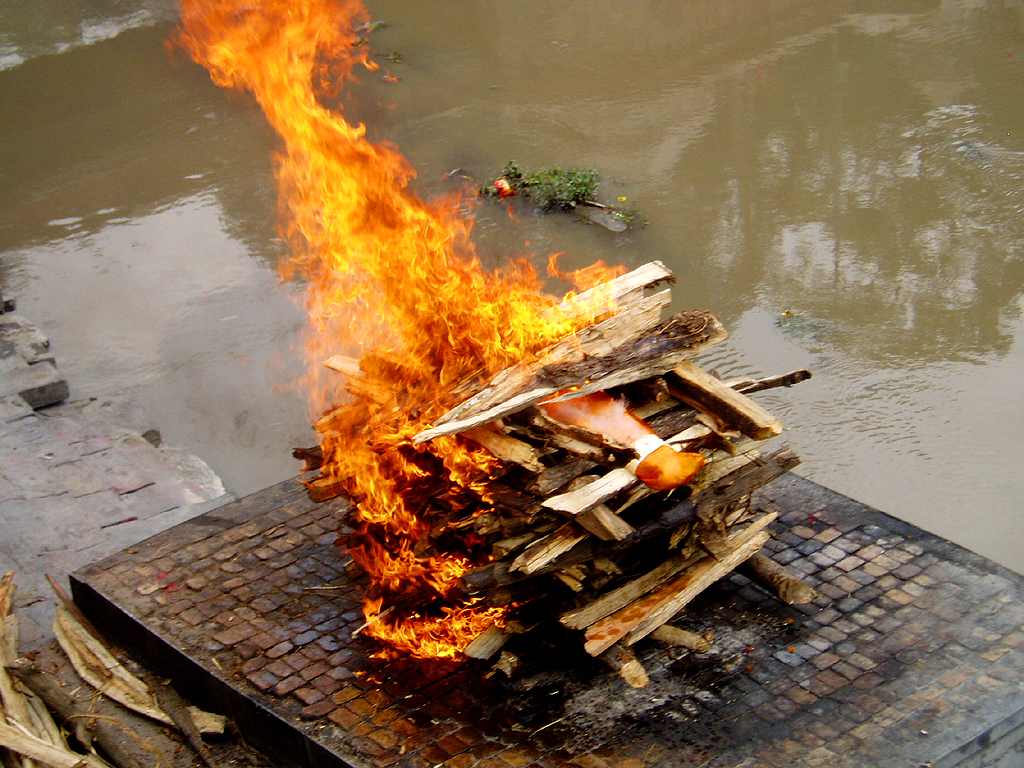 The final rites of a burial, in case of untimely death of a child, is rooted in Rig Veda's section 10.18, where the hymns mourn the death of the child, praying to deity Mrityu to "neither harm our girls nor our boys", and pleads the earth to cover, protect the deceased child as a soft wool.
The last rites are usually completed within a day of death. His or her body is washed, wrapped in white cloth if the dead is a man or a widow (red if her husband is still alive), the two toes tied together with a string, a ''Tilak'' (red mark) placed on the forehead. The dead adult's body is carried to the cremation ground near a river or water, by family and friends, and placed on a pyre with feet facing south. The eldest son, or a male mourner, or a priest then bathes before leading the cremation ceremonial function.Carrie Mercier (1998), Hinduism for Today, Oxford University Press, , page 58 He circumambulates the dry wood pyre with the body, says a eulogy or recites a hymn in some cases, places sesame seed in the dead person's mouth, sprinkles the body and the pyre with ghee (clarified butter), then draws three lines signifying ''Yama'' (deity of the dead), ''Kala'' (time, deity of cremation) and the dead. The pyre is then set ablaze, while the mourners mourn. The ash from the cremation is consecrated to the nearest river or sea. After the cremation, in some regions, the immediate male relatives of the deceased shave their head and invite all friends and relatives, on the tenth or twelfth day, to eat a simple meal together in remembrance of the deceased. This day, in some communities, also marks a day when the poor and needy are offered food in memory of the dead.
The final rites of a burial, in case of untimely death of a child, is rooted in Rig Veda's section 10.18, where the hymns mourn the death of the child, praying to deity Mrityu to "neither harm our girls nor our boys", and pleads the earth to cover, protect the deceased child as a soft wool.
The last rites are usually completed within a day of death. His or her body is washed, wrapped in white cloth if the dead is a man or a widow (red if her husband is still alive), the two toes tied together with a string, a ''Tilak'' (red mark) placed on the forehead. The dead adult's body is carried to the cremation ground near a river or water, by family and friends, and placed on a pyre with feet facing south. The eldest son, or a male mourner, or a priest then bathes before leading the cremation ceremonial function.Carrie Mercier (1998), Hinduism for Today, Oxford University Press, , page 58 He circumambulates the dry wood pyre with the body, says a eulogy or recites a hymn in some cases, places sesame seed in the dead person's mouth, sprinkles the body and the pyre with ghee (clarified butter), then draws three lines signifying ''Yama'' (deity of the dead), ''Kala'' (time, deity of cremation) and the dead. The pyre is then set ablaze, while the mourners mourn. The ash from the cremation is consecrated to the nearest river or sea. After the cremation, in some regions, the immediate male relatives of the deceased shave their head and invite all friends and relatives, on the tenth or twelfth day, to eat a simple meal together in remembrance of the deceased. This day, in some communities, also marks a day when the poor and needy are offered food in memory of the dead.
Samskara in Jainism
Similar to Hinduism, samskara serve as a rite of passage into a new phase of life in different sects of Jainism. In the Digambara school, all 16 Hindu samskaras (see above) were incorporated by Jinasena in the ''Adipurana'' as part of 53 ''kriyas'', of which 23 rites of passage are described for the Jain householder, with the last culminating in renunciation of household life. For those who skip the householder stage of life, the equivalent rite of passage was the 11th ''pratima'', and called ''diksha'' (initiation into mendicancy). In the Śvētāmbara school, 16 samskaras similar to the Hindu rites of passage are described, for example, in the ''Acara-Dinakara'' of Vardhamana. It includes rituals described above, such as those associated with conception, birth, name giving, ear piercing, baby's first haircut, studentship, wedding and death.Kristi L. Wiley (2009), A to Z of Jainism, , pages 186-187 There are some differences between symbolism associated with samskara rites in Hinduism and Jainism. The fire ceremony has Vedic significance in the former, while it symbolizes the ''Tirthankaras'', ''Ganadharas'' and ''Kevalins'' in Jainism. The mantras are often derived from Vedic texts in Hinduism, while they are derived from Jain texts such as Ratnatraya in Jainism. The oaths in some rites of passage include the vow ofSanskars in Sikhism
Although seeks may individually recognise many rites of passage, four are universally important in Sikh religious life. They are the four main ''sanskars'': # Naam Karan, "Naming a Child" ― the rite of naming a newborn at the Gurdwara; traditionally, it is during this rite that male Sikhs take the middle name Singh and female Sikhs take the middle nameSee also
* Hindu genealogy registers at Haridwar * Dharmasutras * Kalpa (Vedanga) * Vedas *References
Further reading
Critical analysis of childhood samskaras (sacraments) in light of contemporary science
Deepshikha and Rai Amit Kumar (2014), Int. Journal Ayur. Pharma Research, 2(2), pp. 95–100.
Culture as the Designer
Lalit Das (2005), Design Issues, MIT Press, 21(4), pp. 41–53.
The Existential, Social, and Cosmic Significance of the Upanayana Rite
Carl Olson (1977), Numen, Vol. 24, Fasc. 2, pp. 152–160. *Thomas N. Siqueira, ''The Vedic Sacraments'', Thought, Volume 9, Issue 4, March 1935, pp. 598–609, .
External links
{{DEFAULTSORT:Samskaram Ceremonies Hindu rituals Rites of passage es:Saṃskāra